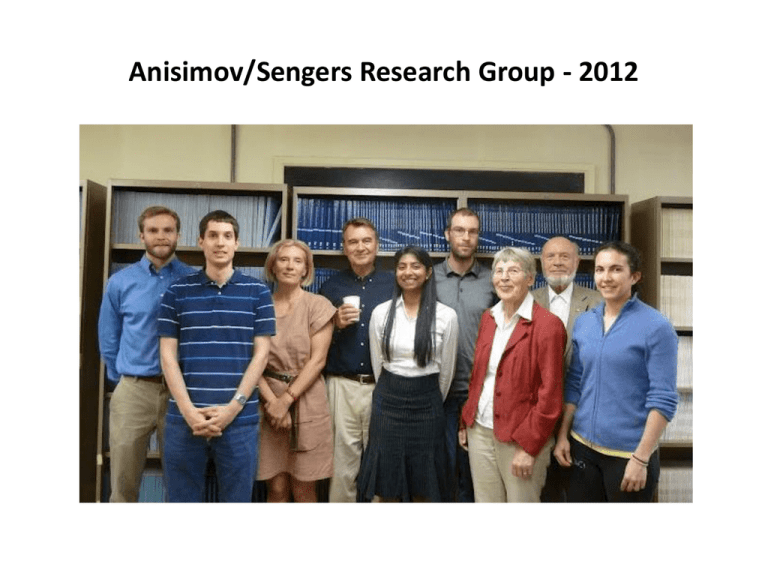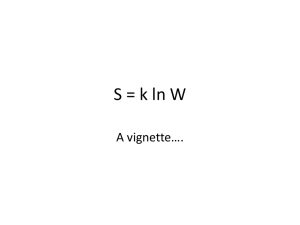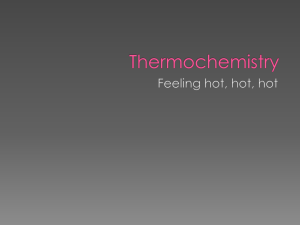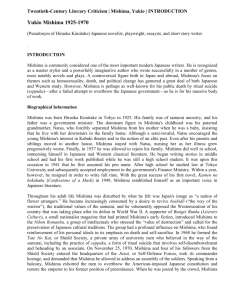Entropy-Driven Liquid-Liquid Separation in Supercooled Water
advertisement

Anisimov/Sengers Research Group - 2012 HOW PURE WATER CAN UNMIX Mikhail Anisimov Institute for Physical Science &Technology and Department of Chemical & Biomolecular Engineering, University of Maryland, College Park 108th StatMech , Rutgers University December 16, 2012 A JOURNEY FROM HOT TO COLD WATER ONE SUBSTANCE – TWO DIFFERENT LIQUIDS Discovery of supercooled water Supercooled water was first described in 1721 by Fahrenheit. The air temperature in the thermometer was marked at fifteen degrees [–9 °C ]. After one hour, I found the water was still fluid in the ball. [D. G. Fahrenheit, Phil. Trans. 33, 78 (1724)] Supercooled water exists in nature • In clouds, water droplets can be liquid down to about –38 °C (–36 °F) • When an airplane flies through a supercooled water cloud, the droplets will freeze on impact: icing 400 -80 -60 -40 0 °C -20 300 Pressure (MPa) Metastable liquid water at –90 °C stable liquid water supercooled water (metastable) 200 TH 100 Homogeneous ice nucleation TM no man's land 0 180 200 220 240 Temperature (K) 260 280 Supercooled liquid Despretz (1837) 1000 Density (kg/m3) Stable liquid 990 Hare and Sorensen (1987) 980 240 260 Temperature (K) 280 300 WATER: ONE SUBSTANCE – TWO DIFFERENT LIQUIDS High-temperature water: highly compressible, low dielectric constant, no (or little) hydrogen bonds, good solvent for organics Low-temperature water: almost incompressible, very high dielectric constant, strong hydrogen-bond network, good solvent for electrolytes Hodge and Angell 1978 100 Dielectric constant of water (IAPWS) 80 60 40 Liquid 20 0 Vapor 0 100 200 Temperature (°C) 300 400 ONE SUBSTANCE – TWO DIFFERENT LIQUIDS: ISOBARIC HEAT CAPACITY OF LIQUID WATER 10 Supercooled liquid water at 1 bar Saturated liquid water Liquid water at 1 bar Angell et al. 1982 Cp (kJ kg-1 K-1) 8 Red is the prediction by our model 6 4 TH -50 Tc TM 0 100 200 Temperature (°C) 300 400 6.0 Heat capacity CP (kJ kg-1 K-1) Supercooled liquid 5.5 Stable liquid Angell et al. (1982) Archer and Carter (2000) 5.0 HEAT CAPACITY OF WATER UPON SUPERCOOLING 4.5 Anisimov and Voronel (1972) 4.0 240 260 280 300 320 Temperature (K) 340 360 WATER’S POLYAMORPHISM: Second (liquid-liquid) critical point in water (Poole et al. 1992) 400 -80 -60 Pressure (MPa) 300 -40 0 °C -20 supercooled water 200 Brown curve: liquid-liquid coexistence Continuation is Widom line, the line of stability minima stable water dP S dT V Fluctuations of volume: V 2 100 T Fluctuations of entropy: 0 S 2 C 180 200 220 240 260 CP 280 Temperature (K) At the liquid-liquid critical point C the P/T slope is 30 times greater than at the vapor-liquid critical point of water and negative C the location of LLCP as recently suggested by Holten and Anisimov, 2012 Mishima’s experiment (2000) 400 -80 -60 -40 0 °C -20 Ice V 300 Pressure (MPa) Ice III stable water 200 TM TH 100 Ice I C 0 180 O. Mishima, PRL 85, 334 (2000) 200 220 240 Temperature (K) 260 280 How can pure liquid unmix? 1. Energy driven: a second minimum or a special shape of the molecular interaction energy (vapor-liquid is energy driven: lattice gas, van der Waals) 2. Entropy driven: a “mixture” of two “states” with negative entropy of mixing (some polymer solutions, networks) 3. A combination of both dP S H dT V T V Clapeyron's equation itself does not answer whether the liquid-liquid separation is energy-driven or entropy driven [Mishima and Stanley, Nature, 396, 329 (1998)] TWO-STATE MODEL A B, • Assumption: water is a nonideal “mixture” of two configurations of hydrogen bonds: high-density/high-entropy state and a low-density/lowentropy state • The fraction of each state is controlled by thermodynamic equilibrium • Liquid-liquid phase separation occurs when the non-ideality becomes strong enough Suggested equation of state: athermal two-state model A B G G x(G G ) A x B A pure A and B states Gibbs energies kT [ x ln x (1 x )ln(1 x )] ideal mixing entropy contribution kT( P) x(1 x) non-ideal contribution molecular fraction of low-density structure B. Equilibrium fraction is found from =0 GB GA ln K kT K is chemical equilibrium constant of “reaction” thus x is the extent of the reaction This liquid-liquid phase separation is driven by non-ideal entropy Regular-solution unmixing (energy driven) versus athermal-solution (entropy driven) unmixing Regular solution (equivalent to lattice gas/Ising model) Energy-driven phase separation Interaction parameter G GA x(GB GA ) kT [ x ln x (1 x)ln(1 x)] ( P) x(1 x) ω determines the critical temperature The critical pressure is determined by the reaction equilibrium constant: GB GA ln K (T , P ) 0 kT A B, Athermal solution Entropy-driven phase separation G GA x(GB GA ) kT [ x ln x (1 x)ln(1 x) ( P) x(1 x)] ω determines the critical pressure The critical temperature is determined by the reaction equilibrium constant: GB GA ln K (T , P ) 0 kT A B, Fraction of low-density structure x [1] mW model simulations: Moore and Molinero, J. Chem. Phys. 130, 244505 (2009). Liquid-liquid transition is zero ordering field h1. The order parameter is entropy change. For liquid-gas transition the order parameter is the density change. Relations between scaling and physical fields for liquid–liquid and liquid– vapor critical points of water h1 T aP 102 Pressure (MPa) h2 h2 P h1 100 h1 C2 1 S h2 C1 2 V h1 h2 T Liquid Gas 10–2 1 V 2 ( S ) h1= ln K = 0 h1 and h2 are Ising scaling fields 1 and 2 are scaling densities 1 is the order parameter 10–4 200 400 600 Temperature (K) 800 The scaling field h2 determines whether the transition is energy- or entropy-driven. If h2 = ΔT, the transition is energy driven. If h2 = -ΔP, the transition is entropy driven. Heat capacity 100 Angell et al. (1982) Bertolini et al. (1985) Tombari et al. (1999) Archer and Carter (2000) Our model CP (J K-1 mol-1) 95 90 85 80 75 230 240 250 260 270 Temperature (K) 280 290 Compressibility Kanno and Angell (1979) Mishima (2010) our model Compressibility (10-4 MPa-1) 7 H2O 6 TM(melting temperatures) 5 P/MPa 0.1 10 4 50 100 150 190 3 220 240 260 280 Temperature (K) 300 Density 380 200 100 0.1 MPa Temp. of max. density x = 0.12 Density of cold and supercooled water. Black curves are the predictions of the crossover two-state model. TH is the homogeneous nucleation temperature. The red line is the line of maximum density, the green line is a constant LDL fraction of about 0.12. Best description of all available experimental data achieved to date! Conclusions • We accurately describe all property data on supercooled water with a two-state model based on an athermal mixing of two states. This model assumes that the liquid-liquid transition in water is entropy driven. • Heavy water (D2O) shows similar anomalies and can be described by our model equally well. • A regular-solution model (purely energy-driven liquid-liquid phase separation) does not work well (the description quality is an order of magnitude worse). Current Activity • Application to atomistic models of water and to supercooled aqueous solutions. • Adding a solute to supercooled water may move the critical point into the experimentally accessible region.










